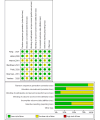Assessing the Content and Effect of Web-Based Decision Aids for Postmastectomy Breast Reconstruction: Systematic Review and Meta-Analysis of Randomized Controlled Trials
- PMID: 38801766
- PMCID: PMC11165285
- DOI: 10.2196/53872
Assessing the Content and Effect of Web-Based Decision Aids for Postmastectomy Breast Reconstruction: Systematic Review and Meta-Analysis of Randomized Controlled Trials
Abstract
Background: Web-based decision aids have been shown to have a positive effect when used to improve the quality of decision-making for women facing postmastectomy breast reconstruction (PMBR). However, the existing findings regarding these interventions are still incongruent, and the overall effect is unclear.
Objective: We aimed to assess the content of web-based decision aids and its impact on decision-related outcomes (ie, decision conflict, decision regret, informed choice, and knowledge), psychological-related outcomes (ie, satisfaction and anxiety), and surgical decision-making in women facing PMBR.
Methods: This systematic review and meta-analysis followed the PRISMA (Preferred Reporting Items for Systematic Reviews and Meta-Analyses) guidelines. A total of 6 databases, PubMed, Embase, Cochrane Library, CINAHL, PsycINFO, and Web of Science Core Collection, were searched starting at the time of establishment of the databases to May 2023, and an updated search was conducted on April 1, 2024. MeSH (Medical Subject Headings) terms and text words were used. The Cochrane Risk of Bias Tool for randomized controlled trials was used to assess the risk of bias. The certainty of evidence was assessed using the Grading of Recommendations, Assessment, Development, and Evaluation approach.
Results: In total, 7 studies included 579 women and were published between 2008 and 2023, and the sample size in each study ranged from 26 to 222. The results showed that web-based decision aids used audio and video to present the pros and cons of PMBR versus no PMBR, implants versus flaps, and immediate versus delayed PMBR and the appearance and feel of the PMBR results and the expected recovery time with photographs of actual patients. Web-based decision aids help improve PMBR knowledge, decisional conflict (mean difference [MD]=-5.43, 95% CI -8.87 to -1.99; P=.002), and satisfaction (standardized MD=0.48, 95% CI 0.00 to 0.95; P=.05) but have no effect on informed choice (MD=-2.80, 95% CI -8.54 to 2.94; P=.34), decision regret (MD=-1.55, 95% CI -6.00 to 2.90 P=.49), or anxiety (standardized MD=0.04, 95% CI -0.50 to 0.58; P=.88). The overall Grading of Recommendations, Assessment, Development, and Evaluation quality of the evidence was low.
Conclusions: The findings suggest that the web-based decision aids provide a modern, low-cost, and high dissemination rate effective method to promote the improved quality of decision-making in women undergoing PMBR.
Trial registration: PROSPERO CRD42023450496; https://www.crd.york.ac.uk/prospero/display_record.php?RecordID=450496.
Keywords: decision aids; decision conflicts; internet; mobile phone; postmastectomy breast reconstruction.
©Lin Yu, Jianmei Gong, Xiaoting Sun, Min Zang, Lei Liu, Shengmiao Yu. Originally published in the Journal of Medical Internet Research (https://www.jmir.org), 27.05.2024.
Conflict of interest statement
Conflicts of Interest: None declared.
Figures





Similar articles
-
Feasibility and Efficacy of Decision Aids to Improve Decision Making for Postmastectomy Breast Reconstruction: A Systematic Review and Meta-analysis.Med Decis Making. 2019 Jan;39(1):5-20. doi: 10.1177/0272989X18803879. Med Decis Making. 2019. PMID: 30799692
-
Effect of shared decision-making in patients with breast cancer undergoing breast reconstruction surgery: A systematic review and meta-analysis.Asia Pac J Oncol Nurs. 2024 Sep 19;11(11):100596. doi: 10.1016/j.apjon.2024.100596. eCollection 2024 Nov. Asia Pac J Oncol Nurs. 2024. PMID: 39582550 Free PMC article. Review.
-
Web-Based Versus Usual Care and Other Formats of Decision Aids to Support Prostate Cancer Screening Decisions: Systematic Review and Meta-Analysis.J Med Internet Res. 2018 Jun 26;20(6):e228. doi: 10.2196/jmir.9070. J Med Internet Res. 2018. PMID: 29945857 Free PMC article.
-
Breast cancer recurrence after immediate and delayed postmastectomy breast reconstruction-A systematic review and meta-analysis.Cancer. 2022 Oct 1;128(19):3449-3469. doi: 10.1002/cncr.34393. Epub 2022 Jul 27. Cancer. 2022. PMID: 35894936 Free PMC article.
-
Web-based decision aids to support breast cancer screening decisions: systematic review and meta-analysis.J Comp Eff Res. 2020 Oct;9(14):985-1002. doi: 10.2217/cer-2020-0052. Epub 2020 Oct 7. J Comp Eff Res. 2020. PMID: 33025800
Cited by
-
Effects of a web-based decision aid on breast cancer patients considering a breast reconstruction: a randomized controlled trial.BMC Womens Health. 2025 May 7;25(1):217. doi: 10.1186/s12905-025-03754-8. BMC Womens Health. 2025. PMID: 40336031 Free PMC article. Clinical Trial.
References
-
- Arnold M, Morgan E, Rumgay H, Mafra A, Singh D, Laversanne M, Vignat J, Gralow JR, Cardoso F, Siesling S, Soerjomataram I. Current and future burden of breast cancer: global statistics for 2020 and 2040. Breast. 2022 Dec;66:15–23. doi: 10.1016/j.breast.2022.08.010. https://linkinghub.elsevier.com/retrieve/pii/S0960-9776(22)00144-8 S0960-9776(22)00144-8 - DOI - PMC - PubMed
-
- Giaquinto AN, Sung H, Miller KD, Kramer JL, Newman LA, Minihan A, Jemal A, Siegel RL. Breast cancer statistics, 2022. CA Cancer J Clin. 2022 Nov 03;72(6):524–41. doi: 10.3322/caac.21754. https://onlinelibrary.wiley.com/doi/10.3322/caac.21754 - DOI - DOI - PubMed
-
- Pfeiffer RM, Webb-Vargas Y, Wheeler W, Gail MH. Proportion of U.S. trends in breast cancer incidence attributable to long-term changes in risk factor distributions. Cancer Epidemiol Biomarkers Prev. 2018 Oct;27(10):1214–22. doi: 10.1158/1055-9965.EPI-18-0098. https://europepmc.org/abstract/MED/30068516 1055-9965.EPI-18-0098 - DOI - PMC - PubMed
-
- Siegel RL, Miller KD, Fuchs HE, Jemal A. Cancer statistics, 2021. CA Cancer J Clin. 2021 Jan 12;71(1):7–33. doi: 10.3322/caac.21654. https://onlinelibrary.wiley.com/doi/10.3322/caac.21654 - DOI - DOI - PubMed
Publication types
MeSH terms
LinkOut - more resources
Full Text Sources
Medical
Miscellaneous

